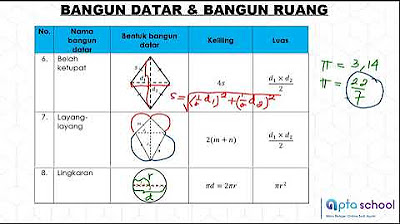BELAJAR ONLINE DI RUMAH MATEMATIKA KELAS 8, UNSUR DAN KERANGKA BANGUN RUANG SISI DATAR-Abi Muis Math
Summary
TLDRThis educational video provides an in-depth explanation of solid geometry, focusing on polyhedra with flat faces, such as cubes, rectangular prisms, and prisms with various polygonal bases. The presenter covers the elements of these shapes, including vertices, edges, faces, and diagonals, along with their specific properties. The tutorial also explains how to calculate the total length of edges for cubes and rectangular prisms, using practical examples. The video concludes with problem-solving exercises, allowing viewers to apply the concepts learned to real-life scenarios.
Takeaways
- 😀 The video discusses the concepts of flat-sided space figures, focusing on their elements.
- 😀 Cubes, rectangular prisms, prisms, and pyramids are examples of space figures with flat sides.
- 😀 A cube has 8 vertices, 12 edges, and 6 square faces, with diagonals that cross each other within the figure.
- 😀 The video explains the specific names of various prisms based on their base shape, such as triangular or quadrilateral prisms.
- 😀 The rectangular prism shares the same elements as the cube but with edges of different lengths.
- 😀 Prisms are classified by their base shape, such as triangular or quadrilateral prisms.
- 😀 The discussion includes the importance of diagonals in space figures, both face diagonals and space diagonals.
- 😀 The number of edges, faces, and diagonals in various prisms is explained, with specific examples like a triangular prism.
- 😀 A detailed explanation is given about calculating the total edge lengths in a cube and rectangular prism.
- 😀 Practical problems are used, such as calculating how many cubes can be made from a given length of wire, demonstrating the application of these concepts.
Q & A
What is the topic of the video?
-The video explains the elements of flat-sided 3D shapes, specifically focusing on prisms, cubes, and rectangular blocks.
What are the key components of a cube as discussed in the video?
-A cube has 8 vertices (corners), 12 edges (ribs), and 6 square faces. The video explains the concept of diagonal edges and surfaces.
How is a rectangular prism different from a cube?
-A rectangular prism has edges of different lengths, unlike a cube where all edges are of the same length. Both have 8 vertices and 6 faces, but the faces of a rectangular prism are rectangular, not square.
What is a prism, and how is it named?
-A prism is a 3D shape with two identical parallel bases. It is named based on the shape of its base (e.g., triangular prism, rectangular prism).
How does the concept of diagonal sides and spaces apply to a cube?
-A cube has face diagonals (diagonal lines within the faces) and space diagonals (diagonal lines connecting opposite corners). The video highlights the significance of these diagonals in understanding the cube's structure.
How is the number of diagonals in a rectangular prism calculated?
-In a rectangular prism, the number of diagonals can be calculated by considering the face diagonals and space diagonals. The video explains that a rectangular prism has several face and space diagonals.
What formula is used to calculate the total length of edges (ribs) in a cube?
-The total length of the edges in a cube can be calculated by multiplying the length of one edge by 12, as there are 12 edges in a cube.
What is the process to determine how many cubes can be made from a given length of wire?
-To calculate how many cubes can be made from a given length of wire, divide the total length of the wire by the total length of the edges of one cube, and round down to the nearest whole number.
How many vertices, edges, and faces does a triangular prism have?
-A triangular prism has 6 vertices, 9 edges, and 5 faces. The faces include 2 triangular bases and 3 rectangular lateral faces.
What calculation is involved when determining the number of prisms in the video example?
-In the example, the video shows the process of determining the number of rectangular prisms that can be made from a given length of wire, involving the calculation of the total edge length of a rectangular prism and dividing the available wire length by this total.
Outlines

This section is available to paid users only. Please upgrade to access this part.
Upgrade NowMindmap

This section is available to paid users only. Please upgrade to access this part.
Upgrade NowKeywords

This section is available to paid users only. Please upgrade to access this part.
Upgrade NowHighlights

This section is available to paid users only. Please upgrade to access this part.
Upgrade NowTranscripts

This section is available to paid users only. Please upgrade to access this part.
Upgrade Now5.0 / 5 (0 votes)





